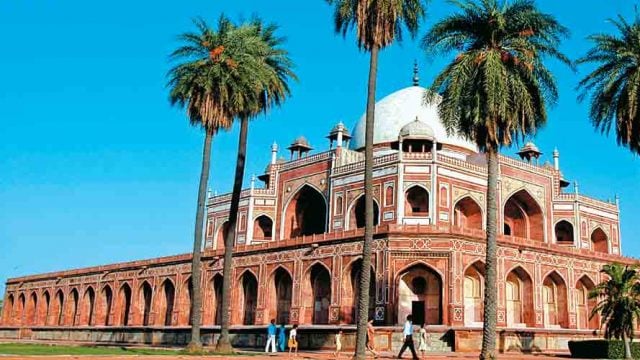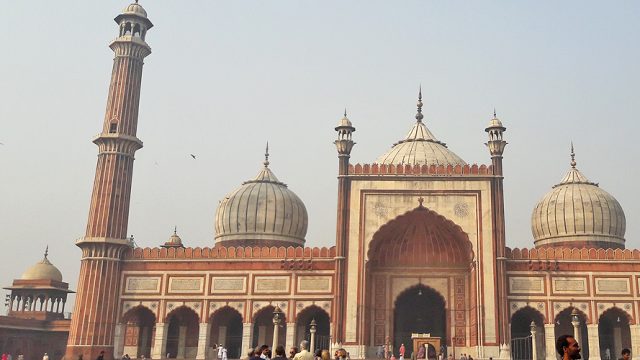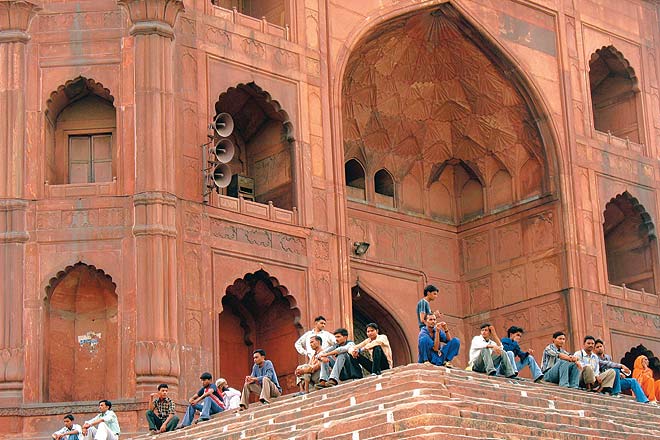There are exactly 69 steps between the new Meena Bazaar and Gate 2
Wasim taps my shoulder and says, “One-fifty.” Still camera, I tell him hopefully. But he says it does not matter, “One-fifty.” Have it your way, I say, I’m not going inside. But he doesn’t like my sitting down on the steps either. Half a minute later, he taps me with a broken plank. “Sit elsewhere.”
The May sun is living up to its 2pm reputation, which no doubt explains the lack of life on the Masjid’s steps. It’s not long since the 1.15 namaaz got over but the courtyard inside is quiet. Only a group of young boys — locals, I am sure — a few poor, weary families and two chana sellers have apportioned the gate’s slim shadow on the top landing.
The cop at the police checkpoint halfway down the steps does not even look up as I trot past him, all the way down and then on to Gate 1, which overlooks Matia Mahal. There’s a bustling market across the road from the Masjid on this side but I only notice the shops selling religious books and kebabs.
Gate 1 is only half as big as Gate 2, with only half as many steps leading up to it — 32, to be precise — but it is equally lifeless. The darban, Munne, who is at least twice Wasim’s age, sits calmly inside the gateway. He has served at the Masjid for 22 years. I ask him about his routine, and that of his fellow attendants: who opens the door and when, who cleans the steps and so on, and get the most uninteresting reply: “I do.”
“This is the most important gate,” he says, “the first to open and the last to close — most people enter and leave the Masjid through it.” The three gates have different timings? “Yes, Gate 2, which is known as the Shahi Darwaza as it was meant for the emperor’s entry, has always opened at 12 noon and closed at 7pm, while Gate 1 remains open from 4am to an hour after the last namaaz, which takes place at 8.45pm in summer.”
Are the steps always so deserted?, I ask Naseem. “Most of the time now,” he says, adding, “there was a time when people from nearby areas spent summer evenings enjoying the breeze on the Masjid’s steps. In winter, they gathered here during the afternoon to soak in the sunlight. And regardless of season, there was always a crowd of railway passengers killing time on the steps before boarding their trains from the Old Delhi Railway Station nearby.”
‘Special’ tea has arrived. The older cop says it is the ultimate restorative. Sure, one cup has enough sugar for six, possibly more. So, when are the steps most crowded, I ask Naseem. On Thursdays and Sundays, he says. Sundays I can understand, but why Thursdays? “Because that’s when the Prophet’s relics are displayed inside the Masjid.”
It’s half-past-three as I cross the Masjid’s courtyard over to Gate 3 on the Dariba side. This gate is even quieter, if anything. I count aloud — 36 steps — much to the amusement of Syed Waqar Ahmed, hereditary caretaker of the Prophet’s relics. “It’s not like the old times anymore,” he says on learning of my purpose, “our elders told us of the times when the leading lights of the Independence Movement held discussions on these steps. Even we grew up seeing impromptu mushairas and kite flying on the steps. Pigeons used to be sold here, and bhishtis (water carriers) used to clang their silver bowls musically. And can I ever forget the kakri sellers’ spiel, “Laila ki anguliyan, Majnu ki pasliyan, chaar aane ki dus le lo (they are as delicate as Laila’s fingers and Majnu’s ribs, take 10 for four annas).”
I spend some time chatting with Syed saab, discussing a book on Delhi’s history that he’s editing. By the time I return to Gate 2, it’s 4.30pm and things are looking up. Meena Bazaar is alive, there are people on the steps, although not as many as I had imagined there would be. The biryaniwalas and the sherbatwalas are doing brisk business. The bhishtis have taken up positions on the steps and are pouring water out into silver cups from their goatskins. Soon the Masjid’s loudspeakers begin summoning the faithful to the 5.30 namaaz, the crowds around the steps get moving.
Related Stories

A Delhi Heritage Holiday, Where Stories Are Set In Stone
From historical monuments to crowded shopping malls, from Mughal gardens to the Delhi University campus, Delhi has multiple personalities making it ‘The good, the bad and the ugly’

20 for 2017, Part 2
The hottest travel ideas for the new year

New Delhi: Old Delhi on a Rickshaw
Take a rickshaw tour of Old Delhi to go back in time


